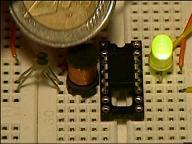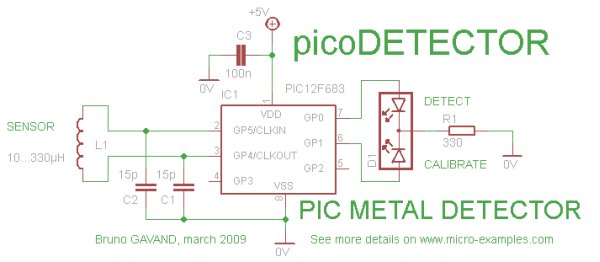A short video clip is sometimes better than a long explanation :
The idea of this circuit is to hack PIC oscillator circuit, by replacing the crystal by a coil : the frequency of the oscillator then depends on presence of metal near the coil, just like in a classic metal detector.
To detect changes of main oscillator frequency, we use the PIC watchdog as internal time reference.
By comparing both oscillators frequencies, we can know if a piece of metal is near the coil, and then light a LED.
It shares the same idea as PicoBat, the ultrasonic bat detector.
 Circuit Schematic
Circuit Schematic
- Coil L1 replaces crystal in PIC oscillator circuit : try with the coils you have to find the best one ! if calibrate LED blinks on power up, it works.
- D1 is a dual color LED, replace with two classic LEDs if you don’t have one.
C Source code
/*
************************************************************
* picoDetector: an ultra-simple and cheap metal detector
************************************************************
*
* Author : Bruno Gavand, april 2009
* see more details on http://www.micro-examples.com/
*
* source code for mikroC PRO compiler V1.65
* feel free to use this code at your own risks
*
* target : PIC12, oscillator in HS mode, watchdog enabled
*
* PIC PIN Assignemnt :
*
* GP0 : detect LED indicator
* GP1 : calibrate LED indicator
* GP2 : NC
* GP3 : NC
* GP4, GP5 : inductor
*
************************************************************
*/
#define MAXTRY 15
// number of watchdog restart to calibrate loop counter
unsigned char ctr ;
// number of loops between two watchdog resets
unsigned char previous ;
// previous value of ctr
unsigned char calibr ;
// calibration value when oscillator runs free
unsigned char restarts ;
// number of watchdog restarts
unsigned char en ;
// enable flag, allows detection
/*
* main loop
*/
void main()
{
unsigned char i ;
/*
* configure GPIO as digital port
*/
CMCON0 = 7 ;
ANSEL = 0 ;
TRISIO = 0 ;
GPIO = 0 ;
/*
* power up ?
*/
if(STATUS.NOT_TO)
{
/*
* yes, init variables
*/
restarts = 0 ;
calibr = 1 ;
}
/*
* watchdog reset counter
*/
if(restarts < 255) restarts++ ;
/*
* if counter differs too much from calibration value
*/
if((previous ^ ctr) > calibr)
{
/*
* turn detect LED on
*/
GPIO.F0 = en ;
/*
* if not on power up
*/
if(STATUS.NOT_TO == 0)
{
/*
* while in calibration mode
*/
if(restarts < MAXTRY)
{
/*
* shift calibration value
* and wait a little bit
*/
calibr <<= 1 ;
Delay_ms(5) ;
}
}
else
{
/*
* turn detect LED off
*/
GPIO.F0 = 0 ;
}
}
/*
* save last counter
*/
previous = ctr ;
/*
* is calibration over ?
*/
if(restarts > MAXTRY)
{
/*
* yes, turn calibrate LED off
* and set enable flag
*/
GPIO.F1 = 0 ;
en = 1 ;
}
else
{
/*
* no, turn calibrate LED on
* and clear enable flag
*/
GPIO.F1 = 1 ;
en = 0 ;
}
 /*
* set watchdog prescaler
*/
OPTION_REG = 0b11111001 ;
/*
* start counter, to be interrupted by watchdog
*/
ctr = 0 ;
for(;;)
{
ctr++ ;
}
}
For more detail: PicoDetector : a PIC-based simple and cheap metal detector
/*
* set watchdog prescaler
*/
OPTION_REG = 0b11111001 ;
/*
* start counter, to be interrupted by watchdog
*/
ctr = 0 ;
for(;;)
{
ctr++ ;
}
}
For more detail: PicoDetector : a PIC-based simple and cheap metal detector

